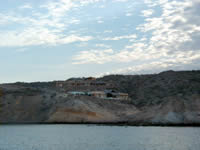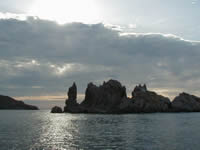| Volume
79
San Juanico & La Ramada
 Eighteen
miles north of Isla Coronados is a bay that might have been designed
solely to reward the intrepid for leaving behind the delights for
the Loreto area. San Juanico as it is known to cruisers (and San
Basilio as it appears on navigation charts) is a collection of coves
tucked in amongst rock pillars and sweeping swaths of lemon yellow
sandstone. At least, those were the most memorable landmarks to
us. Eighteen
miles north of Isla Coronados is a bay that might have been designed
solely to reward the intrepid for leaving behind the delights for
the Loreto area. San Juanico as it is known to cruisers (and San
Basilio as it appears on navigation charts) is a collection of coves
tucked in amongst rock pillars and sweeping swaths of lemon yellow
sandstone. At least, those were the most memorable landmarks to
us.
On the north shore, above
the sandstone were three luxury houses, two of them sculpted tastefully
into the landscape (the other looking rather like a sore thumb).
Nothing else man made was in sight anywhere, except for a line of
seven blue pup tents along the very white beach of the next cove
west. Whether the houses are private homes or rentals, we never
learned, but for the very first time the Two Captains saw something
to spark the imagination of what could be should we ever decide
to beach ourselves. On the other hand, only God knows how they reach
those houses and how far away the nearest services are.
San Juanico
was another anchorage just made for kayaking, and I launched the
blue machine and spent my first afternoon paddling every corner.
When I was hot and sweaty, we then jumped in the water and swam
to the two rock pinnacles behind which we were anchored. Here we
found the best snorkeling yet of our time in the Sea. The pinnacles
were surrounded with boulder piles shaped to recall the great coral
heads of the Caribbean. These were draped in picturesque algae,
and amongst them swam a very dense and very diverse population of
fish, large and small. Don was beside himself as I had begged him
to leave behind the hunting implements. I was in heaven, free-diving
deep to cruise among these coral lookalikes, pausing to poke into
all the myriad nooks and crannies. Truly for the first time was
I missing the luxury of a scuba tank. The next day, of course, when
we went back fully armed, the visibility had deteriorated and the
fish life thinned. I, however, got treated to a huge school of yellow
jacks unlike any we have in the Caribbean which swarmed around me
on each dive for maybe twenty minutes, only disappearing when the
great white hunter hove into view! Only later did I find out that
the black-barred yellow jacks are supposed to be excellent eating!
 Our
second night in San Juanico saw the wind pipe up in the middle of
the night, which brought us from our beds against the event we’d
have to bolt to hoist the kayak aboard and put away all the things
we’d left carelessly out on deck. We were able to go back
to bed the rest of the night, but with sun-up the swell started
to take its toll and we were driven out around the headland to La
Ramada. Our
second night in San Juanico saw the wind pipe up in the middle of
the night, which brought us from our beds against the event we’d
have to bolt to hoist the kayak aboard and put away all the things
we’d left carelessly out on deck. We were able to go back
to bed the rest of the night, but with sun-up the swell started
to take its toll and we were driven out around the headland to La
Ramada.
La Ramada was 2.3 miles
away by sea, but it is actually connected to San Juanico by an arroyo
behind the houses. Indeed the access road to the houses coils across
the isthmus to the La Ramada side before disappearing inland. The
two anchorages, however, bear little resemblance to one another.
The north-facing La Ramada is shaped by a cobblestone hook to the
northeast and a boulder bank to the west. We had heard through the
grapevine, however, that La Ramada had particularly good fishing
along these rocky shores, and the great white hunter was positively
salivating.
We had had San Juanico
to ourselves, but we found, as we rounded the bend, our fellow cruisers
Kevin and Mona of Dreamcatcher, had been quietly hiding out in La
Ramada for almost a week. There is much to be said for keeping a
low radio profile; all your compadres don’t show up in your
private spot. While there is nothing harder to do than intrude on
a fellow cruiser who has had an anchorage to themselves, there was
not a plethora of options near at hand, so we dropped our hook quietly
behind them.
On our little road trip
to Cabo San Lucas a few weeks ago Don learned a new Spanish word
-- tope (pronounced toe-pay). If all of Don's linguistic education
could work this way, he'd be fluent in Spanish. See a road sign
that says "TOPE" and immediately after, there's a speed
bump. Got it! Baja, Mexico may not have taken to the concept of
road shoulders, but they sure have taken to topes. They're everywhere!
Well, life in Paradise
is not without its little topes. On our first afternoon, Don and
I swam a quarter-mile over to the cobble bank to see what there
was to see. What there was were some big cabrilla (yummy grouper-type
fish). So down goes the great white hunter and thwang goes the speargun.
Now, for those of you not familiar with spear-fishing technique,
you don't just aim down on the fish you want and haul him up. You
have to dive down to its level, hang loose as long as you can until
the fish relaxes and turns back or sideways to you, and then, of
course, you have to hit it. When Don fires off the gun, he is often
at the end of his breath-holding limit. The spear is attached to
the gun with a 20' line and the gun itself floats toward the surface.
In the ideal scheme, Don is hauling in on that line as he drifts
up for his next breath. However this big cabrilla did not give up
gracefully. It darted smartly down into the boulder bank at about
25 feet, deep leaving the gun floating up like a marker buoy about
five feet below the surface. Don and I took turns diving down to
try to back the fish and the spear down and out from where he'd
wedged himself, but at that depth neither of us has tons of time.
In frustration, Don finally swam back to Tackless II (a quarter
mile away) loaded a scuba tank into the dinghy, and rowed (we hadn't
put on the outboard) all the way back...only to realize he'd left
his regulator on the deck. So back he had to row again.
Meanwhile, I'd been checking
on the fish and the spear and on my last dive down discovered that
a large green moray had moved in for the free shish-kebab dinner!
By the time Don got back and down, there were TWO giant green morays
at the feast. Don had already resigned himself to giving up the
fish; he just wanted his spear back. Even with scuba, this took
a little negotiation with the two large eels, but he did prevail,
ripping the spear backward through the fish. I might add, he climbed
right back on his hunting “horse” and went out and secured
us another, slightly-smaller cabrilla for our dinner, taking care
to shoot the fish away from the boulders.
We stayed in
La Ramada through the next day, snorkeling farther along the hook
(and finding little crawly things with antennae...yum!) in the morning,
and then, in the afternoon along the boulders on the west side.
A highlight of this activity, was a school of some fifty bat rays
passing underneath us, making it seem like the whole bottom was
moving! Before dinner, we packed the boat away -- dinghy and kayak
hoisted aboard -- ready for an early start on a long 30-40 mile
trip the next day.
|